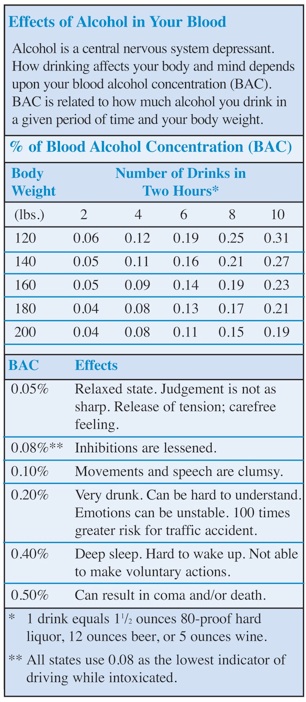-
Freedom from Substance Abuse


200. Alcohol: Know Your Limit and Stick to It
The Effects of Alcohol in Your Blood table below shows approximately how much you have to drink to reach various levels of blood alcohol content (BAC), and what effect alcohol has at those levels.
These are only rough guides, however. How much you drink isn’t the only factor that determines how intoxicated you become. Other factors explain why one person seems to be able to “hold their liquor” (or beer or wine) while another can’t. How tipsy you get when you drink depends on:
How much you’ve eaten.
You get drunk faster on an empty stomach; food slows down the body’s absorption of alcohol.
How long it takes you to finish a drink.
The body metabolizes alcohol at 1/3 ounce per hour. This is a little less than the amount in a 12-ounce beer, a 4 to 5 ounce glass of wine, or a mixed drink with 1-1/2 ounces of 80-proof liquor. So downing two or three drinks in an hour is more intoxicating than sipping those same drinks over the course of an evening.
What you drink.
Generally, the higher the concentration of alcohol, the more quickly alcohol is absorbed. Vodka, for example. is 40 or 50 percent alcohol, so it’s absorbed faster than beer, which averages 3.2 to 5 percent alcohol.
Carbonation.
Carbonated drinks like champagne are absorbed faster than noncarbonated drinks, like wine.
Your weight.
Given equal amounts of alcohol consumed in 1 hour, a lighter person will reach a higher blood alcohol level than a heavier person.
Your age.
Given equal amounts of alcohol, older people generally achieve higher blood alcohol levels than younger people.
Ways to help you stick to your alcohol limit:
-
•Limit the amount of alcohol you buy and keep in the house.
-
•When you drink alcohol, drink it slowly. You are apt to drink less.
-
•When you have a mixed drink, have one with less than the usual amount of alcohol and more of the mixer that goes with it (water, club soda, or seltzer water, etc.).
-
•After you have one or two drinks with alcohol, drink ones without alcohol.
-
•Eat something before you drink. Eat when you drink. Food helps to slow alcohol absorption.
-
•Drink non-alcoholic beverages that look like alcoholic drinks. Examples are:
-
-Alcohol-free champagne.
-
-Alcohol-free beer.
-
-A “Virgin Mary” instead of a Bloody Mary.
-
-Tonic water, cola, etc. in a shorter glass.
-
-A “mocktail” instead of a cocktail. Get non-alcoholic drink recipes on the Internet, such as from www.betterendings.org/Recipes/NonBev.htm.
-
•If you drink when you eat out, order your drink with, not before, your meal.
-
•Keep a daily diary of how much alcohol you drink and where. Do this for a couple of weeks to help you identify your drinking habits and to help you decide what you should do to keep your drinking at a sensible level.
-
•Set a ‘drinking budget’ and stick to it. Think about how much you’re going to drink before you start. If you are going out, it may be helpful to take only enough money to buy the drinks you decide you want to drink. When the “drinking budget” runs out, no more drinks.
-
•Use ways to deal with stress or to relax that do not involve alcohol. Exercise; listen to music; or talk things over with your spouse, partner, or a friend.


Copyright © 2008, American Institute for Preventive Medicine. All rights reserved.


